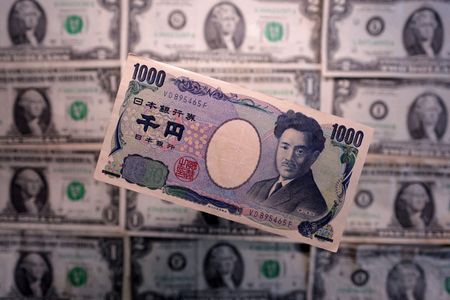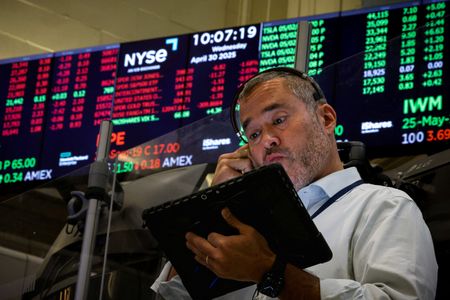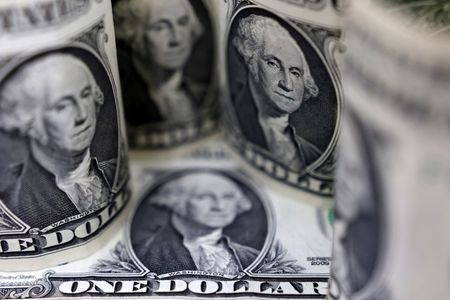By Gertrude Chavez-Dreyfuss and Samuel Indyk
NEW YORK/LONDON (Reuters) -The yen sank on Thursday as the Bank of Japan lowered growth forecasts due to U.S. tariffs and left interest rates on hold, while the dollar continued its bounceback on growing optimism about trade deals between the United States and its partners.
Volume was thinner than normal, as many international markets were closed on Thursday for the May Day holiday.
The Japanese currency dropped to a four-week low against the dollar, which rose 1.7% to 145.45 yen. Against the euro, the yen dropped to a one-month low, with the single currency last up 1.2% at 164.02 yen.
The BOJ’s decision to hold interest rates was unanimous and anticipated, but investors saw the downgraded outlook as reducing the likelihood of future hikes. It now expects underlying consumer inflation to reach its 2% target around the latter half of fiscal 2026 and onward, pushing back the timing by a year from its previous projection in January.
“People have been banking on the BOJ hiking interest rates, but those expectations have moderated now that the BOJ has revised their growth and inflation forecast lower,” said Jayati Bharadwaj, global FX strategist at TD Securities in New York.
The dollar, on the other hand, rose against major currencies such as the euro and sterling, due in part to expectations of deals with many of the country’s trading partners including China. Those deals could soften the blow of U.S. tariffs on most goods.
U.S. Trade Representative Jamieson Greer had said on Wednesday that no official talks were happening with China.
The euro fell to a three-week trough versus the greenback and was last down 0.5% at $1.1273. Sterling also fell, down 0.3% at $1.3293.
“We have been flagging that the dollar has potential to bounce back in the near term, which could potentially give better entry levels to sell it again,” said TD’s Bharadwaj.
“The Trump administration has come to the realization that they might have overplayed their hand when it comes to tariffs and they’re trying to paint a picture of the potential for negotiations.”
A social media account affiliated with Chinese state media said on Thursday that the United States has approached China seeking talks over President Donald Trump’s 145% tariffs, that potentially signals Beijing’s openness to negotiations.
Treasury Secretary Scott Bessent and White House economic adviser Kevin Hassett, also expressed hope for progress in easing trade tensions.
Hassett told CNBC that there have been “loose discussions all over both governments” about the tariffs and China’s easing of duties on some U.S. goods last week was a sign of progress.
TRADE DEALS, WEAK US DATA
Trump said on Wednesday that he had “potential” trade deals with India, South Korea and Japan and that there was a very good chance of reaching a deal with China.
A surge in imports to front-run tariffs dragged U.S. GDP into contraction mode in the first quarter, data showed on Wednesday, though some economists took resilient private demand as a positive sign.
Thursday’s data, however showed continuing weakness.
U.S. initial jobless claims in the latest week surged to a two-month high. Initial claims for state unemployment benefits jumped 18,000 to a seasonally adjusted 241,000 for the week ended April 26, the highest since February. Economists polled by Reuters had forecast 224,000 claims.
A separate report showed U.S. manufacturing contracted further in April while tariffs on imported goods were straining supply chains, keeping prices paid for inputs elevated, and keeping the narrative on stagflation alive and well.
The Institute for Supply Management’s (ISM) manufacturing PMI dropped to a five-month low of 48.7 last month from 49.0 in March, but it was slightly higher than expected. A PMI reading below 50 indicates contraction in the manufacturing sector, which accounts for 10.2% of the economy. Economists polled by Reuters had forecast the PMI declining to 48.
“Overall, national survey data in April (ISM and PMI) do not seem as weak as regional Fed surveys,” wrote Citi analysts in a research note. “But substantial headwinds remain for manufacturing over the coming months.”
In other currencies, the Australian dollar dipped against its strengthening U.S. counterpart after a bumper April that saw it notch a multi-month peak.
The Aussie was last down 0.3% at US$0.6383, having recently found support after a slightly hotter-than-expected inflation reading toned down some of the more dovish bets on the rates trajectory. The New Zealand dollar, meanwhile, sagged 0.5% to $0.5910.
Currency
bid
prices at
1 May
03:02
p.m. GMT
Descripti RIC Last U.S. Pct YTD Pct High Low
on Close Change Bid Bid
Previous
Session
Dollar 100.17 99.672 0.51% -7.67% 100.3 99.6
index 11
Euro/Doll 1.1286 1.1329 -0.38% 9.01% $1.1341 $1.1
ar 27
Dollar/Ye 145.3 143.02 1.64% -7.62% 145.465 142.
n 94
Euro/Yen 163.99 161.97 1.25% 0.47% 164.06 161.
82
Dollar/Sw 0.832 0.8266 0.66% -8.31% 0.8329 0.82
iss 57
Sterling/ 1.3296 1.3335 -0.27% 6.32% $1.3345 $1.3
Dollar 275
Dollar/Ca 1.3835 1.3798 0.28% -3.78% 1.3849 1.37
nadian 85
Aussie/Do 0.6384 0.6403 -0.29% 3.18% $0.6428 $0.6
llar 373
Euro/Swis 0.9389 0.9356 0.35% -0.05% 0.9393 0.93
s 45
Euro/Ster 0.8485 0.8498 -0.13% 2.56% 0.851 0.84
ling 81
NZ 0.5909 0.5937 -0.45% 5.62% $0.5951 0.59
Dollar/Do 05
llar
Dollar/No 10.445 10.3884 0.54% -8.1% 10.4526 10.3
rway 918
Euro/Norw 11.7874 11.7701 0.15% 0.16% 11.819 11.7
ay 732
Dollar/Sw 9.7514 9.6567 0.98% -11.49% 9.7711 9.65
eden 56
Euro/Swed 11.0089 10.942 0.61% -4% 11.0235 10.9
en 309
(Reporting by Samuel Indyk in London and Gertrude Chavez-Dreyfuss in New York; Additional reporting by Tom Westbrook in Singapore; Editing by Mark Heinrich and Gareth Jones, Kirsten Donovan)











